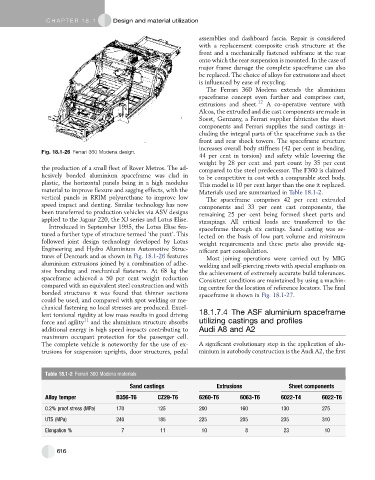Page 605 - Automotive Engineering Powertrain Chassis System and Vehicle Body
P. 605
CHAP TER 1 8. 1 Design and material utilization
assemblies and dashboard fascia. Repair is considered
with a replacement composite crash structure at the
front and a mechanically fastened subframe at the rear
onto which the rear suspension is mounted. In the case of
major frame damage the complete spaceframe can also
be replaced. The choice of alloys for extrusions and sheet
is influenced by ease of recycling.
The Ferrari 360 Modena extends the aluminium
spaceframe concept even further and comprises cast,
extrusions and sheet. 12 A co-operative venture with
Alcoa, the extruded and die cast components are made in
Soest, Germany, a Ferrari supplier fabricates the sheet
components and Ferrari supplies the sand castings in-
cluding the integral parts of the spaceframe such as the
front and rear shock towers. The spaceframe structure
increases overall body stiffness (42 per cent in bending,
Fig. 18.1-26 Ferrari 360 Modena design.
44 per cent in torsion) and safety while lowering the
weight by 28 per cent and part count by 35 per cent
the production of a small fleet of Rover Metros. The ad- compared to the steel predecessor. The F360 is claimed
hesively bonded aluminium spaceframe was clad in to be competitive in cost with a comparable steel body.
plastic, the horizontal panels being in a high modulus This model is 10 per cent larger than the one it replaced.
material to improve flexure and sagging effects, with the Materials used are summarized in Table 18.1-2.
vertical panels in RRIM polyurethane to improve low The spaceframe comprises 42 per cent extruded
speed impact and denting. Similar technology has now components and 33 per cent cast components, the
been transferred to production vehicles via ASV designs remaining 25 per cent being formed sheet parts and
applied to the Jaguar 220, the XJ series and Lotus Elise. stampings. All critical loads are transferred to the
Introduced in September 1995, the Lotus Elise fea- spaceframe through six castings. Sand casting was se-
tured a further type of structure termed ‘the punt’. This lected on the basis of low part volume and minimum
followed joint design technology developed by Lotus weight requirements and these parts also provide sig-
Engineering and Hydro Aluminium Automotive Struc- nificant part consolidation.
tures of Denmark and as shown in Fig. 18.1-26 features Most joining operations were carried out by MIG
aluminium extrusions joined by a combination of adhe- welding and self-piercing rivets with special emphasis on
sive bonding and mechanical fasteners. At 68 kg the the achievement of extremely accurate build tolerances.
spaceframe achieved a 50 per cent weight reduction Consistent conditions are maintained by using a machin-
compared with an equivalent steel construction and with ing centre for the location of reference locators. The final
bonded structures it was found that thinner sections spaceframe is shown in Fig. 18.1-27.
could be used, and compared with spot welding or me-
chanical fastening no local stresses are produced. Excel-
lent torsional rigidity at low mass results in good driving 18.1.7.4 The ASF aluminium spaceframe
force and agility 11 and the aluminium structure absorbs utilizing castings and profiles
additional energy in high speed impacts contributing to Audi A8 and A2
maximum occupant protection for the passenger cell.
The complete vehicle is noteworthy for the use of ex- A significant evolutionary step in the application of alu-
trusions for suspension uprights, door structures, pedal minium in autobody construction is the Audi A2, the first
Table 18.1-2 Ferrari 360 Modena materials
Sand castings Extrusions Sheet components
Alloy temper B356-T6 CZ29-T6 6260-T6 6063-T6 6022-T4 6022-T6
0.2% proof stress (MPa) 170 125 200 160 130 275
UTS (MPa) 240 185 225 205 235 310
Elongation % 7 11 10 8 23 10
616

